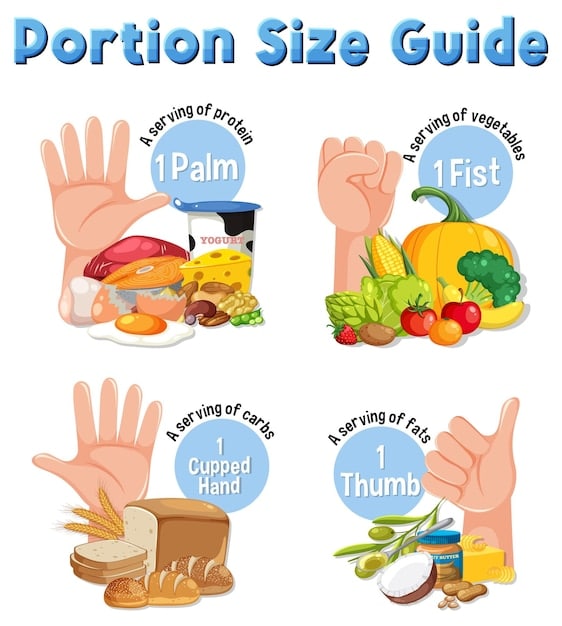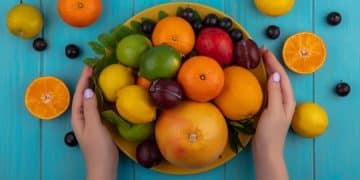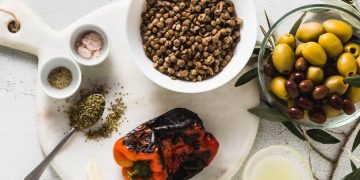How to Read Nutrition Labels Like a Pro: A 2025 Update

Navigating nutrition labels effectively in 2025 requires understanding new guidelines, focusing on core components like serving sizes, added sugars, and nutrient percentages, and applying critical thinking to make informed, healthier food choices for optimal well-being.
Understanding How to Read Nutrition Labels Like a Pro: A 2025 Update is more crucial than ever in our complex food landscape. With evolving regulations and new dietary insights, mastering this skill empowers you to make informed decisions for your health and well-being.
The Evolving Landscape of Nutrition Labels in 2025
The way we approach food and nutrition continues to evolve, and so do the tools designed to help us make better choices. In 2025, nutrition labels are more than just a list of ingredients and numbers; they are a sophisticated guide for navigating an increasingly complex food environment. Understanding the current iteration of these labels is fundamental for anyone serious about their dietary health.
Government agencies and health organizations constantly refine labeling standards, aiming for greater clarity and scientific accuracy. This ongoing process ensures that consumers receive the most relevant information without being overwhelmed. The changes often reflect new scientific consensus, public health priorities, and consumer feedback, making the labels a living document that adapts to our collective understanding of diet and wellness.
Key Shifts in 2025 Labeling Standards
Several significant adjustments have been implemented by 2025 to enhance the utility of nutrition labels. These changes are designed to simplify complex information and highlight key areas of concern for public health, such as added sugars and certain types of fats. Being aware of these shifts is the first step toward effective label interpretation.
- Refined Serving Size Calculations: Serving sizes are now more realistically portrayed to reflect what people actually consume, not just what manufacturers suggest.
- Prominent Added Sugars Declaration: The “Added Sugars” line is now more visually distinct and includes a daily value percentage, making it easier to identify excessive sugar intake.
- Updated Vitamin and Mineral Requirements: Specific daily values for certain vitamins and minerals have been adjusted based on the latest dietary reference intakes, ensuring more accurate recommendations.
- Clearer Allergen Information: While not a new concept, allergen declarations have become even more standardized for consumer safety, often bolded or listed separately.
These updates collectively aim to provide a clearer, more actionable snapshot of a food product’s nutritional profile. By focusing on these specific areas, consumers can quickly assess whether a product aligns with their dietary goals and health needs. The shift is subtle but significant, moving away from simple data presentation to more insightful guidance.
For individuals managing chronic conditions or adhering to specific dietary plans, these enhanced labels can be a game-changer. They provide the granularity needed to manage sodium intake, monitor carbohydrate loads, or ensure adequate fiber consumption. The goal is to demystify nutrition, putting the power of informed choice firmly in the hands of the consumer. This foundational understanding sets the stage for a deeper dive into the specific components of the nutrition facts panel.
Decoding Serving Sizes and Servings Per Container
The journey to mastering nutrition labels begins not with calories, but with the often-overlooked details of serving sizes. These seemingly small numbers are, in fact, the bedrock upon which the entire nutritional profile of a product is built. Without a proper understanding of serving sizes, all subsequent calculations regarding nutrients and calories can be fundamentally misleading. By 2025, emphasis has been placed on making these figures more intuitive and reflective of real-world consumption patterns, yet vigilance remains key.
A “serving size” indicates the standard amount of food that should be consumed per sitting. This amount is typically measured in common units like cups, pieces, or grams, making it easier for consumers to quantify. The “servings per container” then tells you how many of those individual servings are in the entire package. Misinterpreting these two crucial pieces of information is a common pitfall that can lead to significant under or overestimations of nutrient intake and calorie consumption.
Understanding Realistic Portions
One of the most significant changes by 2025 is the push towards more realistic serving sizes. Gone are the days when a single serving of a beverage might be listed as a quarter of a bottle, despite most people consuming the whole thing. Now, labels are designed to reflect what people typically eat or drink at one sitting, which often means larger single serving sizes for many common items like sodas, ice creams, and ready-to-eat meals.
- Single-Serving Containers: For items traditionally consumed in one sitting (e.g., a 20-ounce soda), the label will often list the entire container as one serving, simplifying calculations.
- Multiple Servings in One: If a package contains more than one serving but is likely to be eaten in a single sitting, calorie and nutrient information might be provided per serving and per package.
- Consistency Across Similar Products: Efforts have been made to standardize serving sizes across similar food categories, allowing for easier comparison between brands.
This pragmatic approach to serving size helps bridge the gap between manufacturer recommendations and actual consumer behavior. It reduces the need for mental math when you eat an entire bag of chips or drink a whole bottle of juice, providing an immediate and accurate overview of the total nutritional impact.
However, even with these improvements, it’s vital to remain aware. If you consume two listed servings of a product, you must double all the nutrient values—calories, fats, sugars, and so on. This simple multiplication is critical for accurate tracking of your dietary intake. Always glance at the serving size first, even for products you’ve bought many times, as formulations and labeling can change. Being proactive in this initial step sets a precise foundation for interpreting the rest of the label.
Calories and Macronutrients: The Energy Equation
Once you’ve grasped serving sizes, the next logical step is to delve into calories and macronutrients. These are the primary components that dictate the energy content and foundational building blocks of your diet. In 2025, labels continue to highlight these elements, allowing consumers to effectively manage their energy intake and balance their diet for optimal health. A deeper understanding of what each macronutrient contributes is essential beyond just the numbers.
Calories, represented prominently on the label, are the unit of energy derived from food. They fuel all bodily functions, from breathing to exercising. Alongside calories, the label details three main macronutrients: total fat, total carbohydrates, and protein. Each of these plays a distinct role in health and contributes a different amount of energy per gram, making their balance crucial for a well-rounded diet.
Breaking Down Fat, Carbohydrates, and Protein
Understanding the types and quantities of macronutrients helps you identify the quality of your food choices. Not all fats are equal, nor are all carbohydrates. Protein, meanwhile, is fundamental for muscle repair and growth. By 2025, labels provide a more nuanced view, allowing for more informed decisions than simply focusing on total grams.
- Total Fat: This section now emphasizes distinguishing between beneficial unsaturated fats (monounsaturated and polyunsaturated) and less desirable saturated and trans fats. The focus is increasingly on replacing saturated fats with healthier alternatives rather than just reducing total fat.
- Total Carbohydrates: This category includes sugars, dietary fiber, and complex carbohydrates. The “Added Sugars” declaration is particularly important here, as it differentiates naturally occurring sugars from those added during processing. Adequate fiber intake is also highlighted for digestive health.
- Protein: While often associated with muscle building, protein is vital for countless bodily functions. Labels detail total protein content, with some high-protein foods also indicating the quality or amino acid profile.

When evaluating these macronutrients, it’s not just about the grams; it’s also about their impact on daily values and overall satiety. For example, foods high in fiber and protein tend to keep you feeling full longer, which can aid in weight management. Conversely, foods high in added sugars, while providing energy, often lack nutritional density and can lead to energy crashes.
By carefully reviewing these sections, you can align your food choices with specific health goals, whether that’s managing blood sugar, heart health, or athletic performance. The 2025 labels empower you to look beyond the calorie count and understand the composition of the nutrients that make up your meal. This in-depth analysis of macronutrients paves the way for understanding the role of micronutrients and daily values in achieving complete nutrition.
Spotlight on Added Sugars and Sodium: Critical Health Indicators
Two of the most impactful changes to nutrition labels by 2025 have centered on making “Added Sugars” and “Sodium” far more prominent and understandable. These two ingredients are critical health indicators, widely linked to prevalent health issues like obesity, type 2 diabetes, and cardiovascular disease. Prioritizing their identification on the label is a direct response to public health concerns, arming consumers with direct information. Learning to quickly assess these values is paramount for proactive health management.
The intention behind highlighting added sugars is to differentiate them from naturally occurring sugars found in fruits and dairy. It’s the added sugars—often hidden in unexpected places like salad dressing, bread, and yogurt—that contribute to empty calories and can negatively impact health without providing significant nutritional benefit. Similarly, excess sodium intake is a major contributor to high blood pressure, and managing it is crucial for heart health. These clear declarations help in making swift, informed dietary choices.
Navigating the New Added Sugars Declaration
The “Added Sugars” line is now one of the most significant changes consumers should pay attention to. It explicitly states the amount of sugar that has been added to a product during processing, distinguishing it from sugars naturally present in ingredients. This makes it easier to track and limit intake.
- Gram Amount and % Daily Value: Both the total grams of added sugars and the percentage of the daily recommended limit are clearly displayed. Aim for lower percentages to avoid exceeding recommended daily intake.
- Impact on Health: High intake of added sugars is linked to weight gain, increased risk of heart disease, and dental cavities. Being aware of this number empowers you to choose products with little to no added sugars.
- Hidden Names: Be mindful that added sugars can still appear under various names in the ingredient list (e.g., high-fructose corn syrup, dextrose, maltose, cane sugar, honey, maple syrup).
When assessing the added sugars, look for products that contain 5% Daily Value or less per serving. A product with 20% Daily Value or more is considered high in added sugars, and consumption should be limited. This quick visual cue bypasses the need to identify complex alternative names for sugar in the ingredients list, making the label far more user-friendly for this specific health metric.
Monitoring Sodium for Heart Health
Sodium remains a key concern for public health, and its clear presentation on nutrition labels helps consumers manage their intake effectively. High sodium intake contributes to high blood pressure, increasing the risk of heart attack and stroke. The label is your first line of defense against excessive hidden salts in processed foods.
- Daily Value Focus: The % Daily Value for sodium is critical. Aim for foods with a lower percentage per serving, especially if you monitor your blood pressure.
- Processed Foods Alert: Many processed and packaged foods surprisingly contain high levels of sodium, even if they don’t taste particularly salty. Check items like canned soups, frozen meals, and even bread.
- “Low Sodium” vs. “Reduced Sodium”: Understanding these terms is important. “Low sodium” means 140 mg or less per serving, while “reduced sodium” means at least 25% less sodium than the original product.
Both added sugars and sodium require an active approach from the consumer. By prioritizing these two sections on the nutrition label, you can significantly improve your dietary quality and reduce your risk of chronic diseases. The 2025 updates provide the clarity needed to make these essential health decisions quickly and confidently as you scan supermarket shelves.
Navigating the Ingredient List: Beyond the Numbers
While the Nutrition Facts panel provides a quantitative breakdown of nutrients, the ingredient list offers a qualitative insight into what truly makes up your food. It’s a critical section often overlooked but, by 2025, understanding its nuances is more important than ever for discerning consumers. This list provides transparency, revealing the actual components of a product, from whole ingredients to various additives and preservatives. Learning to interpret it correctly can unveil critical information that the numerical panel might not fully convey.
Ingredients are listed in descending order by weight, meaning the first few items on the list are the most abundant in the product. This fundamental rule is key to identifying concentrations of less desirable components like excessive sugars, unhealthy fats, or refined grains. A long list of unfamiliar names might also be a red flag, indicating a highly processed product with numerous additives, which can influence your perception of its overall nutritional value and naturalness.
Identifying Whole Foods and Problematic Additives
A discerning eye over the ingredient list can quickly help you categorize a food product. The presence of whole, recognizable ingredients typically indicates a less processed and healthier option. Conversely, certain ingredients warrant closer inspection, especially if they appear high up on the list.
- Look for Whole Ingredients First: Prioritize products where fruits, vegetables, whole grains, nuts, seeds, and lean proteins appear at the top of the list. This suggests a nutrient-dense foundation.
- Spotting Hidden Sugars: As mentioned, added sugars come in many forms (e.g., corn syrup, dextrose, sucrose, maltodextrin). If multiple forms of sugar appear early in the list, the product likely contains a significant amount of added sugar.
- Unhealthy Fats: Phrases like “partially hydrogenated oil” (trans fats) should be avoided. While fully hydrogenated oils do not contain trans fats, they are still highly processed. Look for healthy fats from sources like olive oil, avocado oil, or nuts.
- Artificial Colors, Flavors, and Preservatives: Many consumers prefer to limit their intake of artificial ingredients. These will be explicitly listed (e.g., “artificial flavor,” “Red 40,” “sodium benzoate”).
Beyond identifying specific problematic ingredients, consider the length and complexity of the list. Generally, shorter ingredient lists with recognizable terms tend to indicate a less processed food. Conversely, a very long list filled with chemical-sounding names may signify a highly processed item, which might have less nutritional value despite boasting certain fortified nutrients on the facts panel.

The ingredient list also provides crucial information for those with allergies or specific dietary restrictions, such as veganism or gluten intolerance. Always double-check for specific allergens like nuts, dairy, soy, or gluten-containing grains. The 2025 guidelines ensure these are often clearly highlighted for immediate identification. Mastering the ingredient list complements your understanding of the nutrition facts panel, providing a holistic view of what you’re consuming. This comprehensive approach empowers you to make truly informed choices, moving beyond just raw numbers to the quality of the food itself.
Daily Values and Percentages: Your Nutritional Compass
Once you’ve dissected serving sizes, scrutinized macronutrients, and delved into the ingredient list, the final piece of the puzzle on nutrition labels is understanding the “% Daily Value” (%DV). This percentage is designed to be your nutritional compass, helping you quickly discern if a serving of food contributes a little or a lot to your daily recommended intake for various nutrients. In 2025, these percentages are standardized to a 2,000-calorie daily diet, providing a universal benchmark for most adults. Mastering this section allows for quick comparisons and informed dietary planning.
The %DV essentially tells you how much of a nutrient a serving of food provides in context of a total daily diet. For example, if a serving of cereal provides 25% of the Daily Value for Vitamin D, it means that one serving gives you one-quarter of the Vitamin D you need each day. This makes it incredibly simple to track intake and ensure you’re getting enough of the good stuff and not too much of the less desirable components.
The “5/20 Rule” and Key Nutrients
A simple yet effective rule of thumb for interpreting %DV is the “5/20 Rule.” This quick guide helps you determine if a food is a good or poor source of a particular nutrient, without needing to memorize specific daily recommendations.
- 5% DV or Less: This means the food is a low source of that nutrient. For nutrients you want to limit (like saturated fat, sodium, and added sugars), aim for 5% DV or less.
- 20% DV or More: This means the food is a high source of that nutrient. For nutrients you want more of (like dietary fiber, Vitamin D, calcium, iron, and potassium), aim for 20% DV or more.
In 2025, particular emphasis is placed on several key “nutrients of concern” that Americans often don’t get enough of, or conversely, consume in excess. These are the nutrients you should focus on when using the %DV:
- Nutrients to Get Enough Of: Fiber, Vitamin D, Calcium, Iron, and Potassium. These are vital for bone health, energy, digestive health, and nervous system function. Look for higher %DVs here.
- Nutrients to Limit: Saturated Fat, Sodium, and Added Sugars. Overconsumption of these can contribute to cardiovascular disease, high blood pressure, and obesity. Aim for lower %DVs here.
It’s important to remember that the 2,000-calorie diet is a general guideline. Your individual calorie and nutrient needs may vary based on age, gender, activity level, and health goals. However, the %DV still provides a useful baseline for comparison, even if your personal daily targets differ. It helps you quickly compare similar products and choose the one that aligns better with your nutritional objectives.
By consistently applying the 5/20 rule and focusing on the identified key nutrients, you can transform the %Daily Value from a mere number into a powerful tool for building a balanced and healthy diet. This approach allows for quick, confident decision-making, turning a potentially overwhelming label into a clear guide for smarter shopping and healthier eating habits.
Applying Your Pro Reading Skills: Beyond the Label
Mastering the art of reading nutrition labels in 2025 extends beyond merely understanding the numbers and lists; it’s about integrating this knowledge into your daily life and developing smarter shopping and eating habits. Armed with a deeper comprehension of serving sizes, macronutrients, added sugars, sodium, ingredient lists, and daily values, you are now equipped to make truly informed decisions that support your long-term health and well-being. This final stage involves critical thinking and practical application, ensuring the label’s insights translate into tangible lifestyle changes.
The goal isn’t just to identify “good” or “bad” foods, but to understand food choices in context. A product high in certain nutrients might still be a good choice if consumed in moderation, or if it fits within a specific dietary plan. Conversely, seemingly healthy items can sometimes harbor hidden sugars or excessive sodium. The “pro” approach involves a holistic view, considering the entire meal and your overall daily intake.
Practical Strategies for Smarter Eating
Putting your label-reading skills into practice involves more than just a quick glance. It requires a strategic approach to grocery shopping and meal preparation, ensuring that the information gleaned from labels guides your choices effectively. By incorporating these habits, you can optimize your diet without feeling overwhelmed.
- Compare Products: Always compare the nutrition labels of similar products (e.g., different brands of yogurt, bread, or cereals). You’ll often find significant differences in sugar, sodium, and fiber content.
- Plan Your Meals: Use label information to pre-plan your meals and snacks, ensuring you meet your nutritional goals for the day and avoid nutrient deficiencies or excesses.
- Focus on Whole, Unprocessed Foods First: Remember, many healthy foods like fresh fruits, vegetables, lean meats, and unsalted nuts don’t even have nutrition labels! Prioritize these as the foundation of your diet.
- Don’t Be Afraid of the “Trade-Off”: Sometimes, a product might be higher in one less desirable nutrient but excellent in others (e.g., high in healthy fats but low in added sugars). Use your discretion to make the best overall choice for your goals.
Beyond individual products, consider how each item fits into your overall dietary pattern. If one meal is higher in sodium, balance it with lower-sodium options throughout the rest of your day. If you consume a product with some added sugar, ensure your other choices are naturally sweet or sugar-free. This contextual understanding prevents an overly restrictive mindset and promotes dietary flexibility.
Continual self-education is also key. Food science and nutritional guidelines evolve, and staying updated ensures your label-reading skills remain sharp. Resources from reputable health organizations, government agencies, and registered dietitians can provide ongoing insights. By diligently applying these pro-level label reading strategies, you gain unparalleled control over your dietary intake, fostering long-term health and a deeper connection with the food you eat.
| Key Takeaway | Brief Description |
|---|---|
| 📊 Serving Sizes First | Always check realistic serving sizes and servings per container before anything else to avoid miscalculations. |
| 🍬 Added Sugars & Sodium | Prioritize these sections. High levels are linked to chronic health issues. Aim for lower %DV. |
| 📜 Ingredient List Insight | Ingredients are by weight; look for whole foods at the top and be wary of long lists or unfamiliar additives. |
| 🧭 Use % Daily Value | Apply the 5/20 rule: 5% DV or less is low, 20% DV or more is high for a nutrient. |
Frequently Asked Questions About Nutrition Labels
The most important part to check first is the serving size and servings per container. This information dictates all other listed nutrient values. If you eat more than one serving, you must multiply all subsequent nutrient amounts accordingly to get an accurate intake for what you consumed.
Total Sugars include both naturally occurring sugars (like those in fruit or milk) and sugars added during processing. Added Sugars specifically refers only to sugars or syrups put into foods or beverages, which are generally the ones consumers should limit for better health.
The “5/20 Rule” is a quick guide for % Daily Value (%DV). If a nutrient’s %DV is 5% or less, it’s considered low in that nutrient per serving. If it’s 20% or more, it’s considered high. Use this to identify foods that are good sources of beneficial nutrients and low in those you want to limit.
The ingredient list provides qualitative information about the food. It tells you exactly what is in the product, listed by weight. This helps you identify whole ingredients versus processed additives, hidden sugars under different names, and potential allergens, offering a more complete picture of the food’s quality.
Yes, the % Daily Values on nutrition labels are typically based on a 2,000-calorie daily diet. While this is a general guideline, it provides a consistent reference point for comparing different foods. Your individual calorie and nutrient needs may vary based on factors like age, gender, and activity level.
Conclusion
As we navigate the complexities of food choices in 2025, the ability to read nutrition labels like a seasoned professional is not just a skill but a vital tool for personal health. This updated approach emphasizes understanding revamped serving sizes, scrutinizing prominent “Added Sugars” and sodium declarations, interpreting comprehensive ingredient lists, and leveraging the power of “% Daily Values.” By adopting these strategies, consumers are empowered to move beyond marketing hype and make truly informed decisions, fostering healthier eating habits that resonate with their individual well-being. This proactive engagement with food labels transforms routine grocery trips into opportunities for profound health enhancement, ultimately leading to a more nourished and mindful lifestyle.





